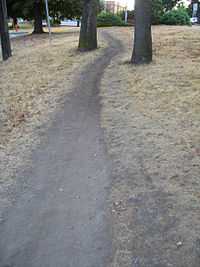Desire path

A desire path (also known as a desire line, social trail, goat track or bootleg trail) can be a path created as a consequence of foot or bicycle traffic. The path usually represents the shortest or most easily navigated route between an origin and destination. The width of the path and its erosion are indicators of the amount of use the path receives. Desire paths emerge as shortcuts where constructed ways take a circuitous route, or have gaps, or are lacking entirely.
In parks and nature areas

In Finland, planners are known to visit their parks immediately after the first snowfall, when the existing paths are not visible.[1] People naturally choose desire lines, which are then clearly indicated by their footprints and can be used to guide the routing of new purpose built paths.
Social trails sometimes cut through sensitive habitats and off-limit areas, threatening wildlife and park security. However, social trails also provide to park management an indicator of activity concentration. The National Park Service unit at the Yosemite National Park in the United States of America uses this indicator to help establish its General Management Plan.[2]
Trampling studies have consistently documented that impacts on soil and vegetation occur rapidly with initial use of desire paths. As few as 15 passages over a site can be enough to create a distinct trail, the existence of which then attracts further use.[3] This body of scholarships contributed to the creation of the Leave No Trace education program, which, among other things, teaches that travelers in nature areas should either stay on designated trails or, when off trail, distribute their travel lines so as to not inadvertently create new trails in unsustainable locations.[4]
Land managers have devised a variety of techniques to block the creation of desire paths. These can be seen alongside many trails and include fencing, dense vegetation, or signage. However, social trails still penetrate these barriers. Because of this, state of the art trail design attempts to avoid the need for barriers and restrictions and instead seeks to bring trail layout and user desires in line with each other - both through physical design and through persuasive outreach to users.[5]
Other uses of the concept
The image of a user created path, in seeming defiance of authority, across the earth between the concrete, has captured the imagination of many as a metaphor for, variously, anarchism, intuitive design, individual creativity, or the wisdom of crowds.[6][7][8][9][10]
In Urban Planning, the concept of desire lines can be used when analyzing traffic patterns in any mode of travel. See, for example, its use in the 1959 Chicago Area Transportation Study to describe choices commuters made about railroad and subway trips.[11]
See also
References
- ↑ "Earls Court Project Application 1: The 21st Century High Street". June 2011.
- ↑ Lubell, Mark. Lecture9: National Park for ESP172, University of California, Davis
- ↑ Hampton, Bruce and David Cole (1988) "Soft Paths" p 27. Stackpole Books, Harrisburg, Pennsylvania. ISBN 0-8117-2234-1
- ↑ Marion, Jeffrey L. and Scott E. Reid. "Development of the U.S. Leave No Trace Program: An Historical Perspective" Leave No Trace: Center for Outdoor Ethics, Boulder, Colorado. January 2001. Retrieved 14 March 2012.
- ↑ Hampton, Bruce and David Cole (1988) "Soft Paths" p 16. Stackpole Books, Harrisburg, Pennsylvania. ISBN 0-8117-2234-1
- ↑ Carl Myhill, "Commercial Success by Looking for Desire Lines", in Masoodian, M, Jones, S, Rogers B, (Eds.) 6th Asia Pacific Computer-Human Interaction Conference (APCHI 2004), (Rotorua, New Zealand, June/July 2004). Springer-Verlag
- ↑ Lidwell, William; Holden, Katrina; Butler, Jill (2010). Universal principles of design: 125 ways to enhance usability, influence perception, increase appeal, make better design decisions, and teach through design. Rockport Publishers. ISBN 1-59253-587-9.
- ↑ Norman, Donald (2010). Living with Complexity. The MIT Press. ISBN 0-262-01486-6.
- ↑ Throgmorton, James and Eckstein, Barbara Desire Lines: The Chicago Area Transportation Study and the Paradox of Self in Post-War America
- ↑ WGBH: A Cape Cod Notebook - Desire Lines by Robert Finch
- ↑ State of Illinois. (1959) "Chicago Area Transportation Study" p. 40. State of Illinois, Springfield, IL. Retrieved 14 March 2012 from Paul V. Galvin Library, Illinois Institute of Technology.
External links
| Wikimedia Commons has media related to Desire paths. |